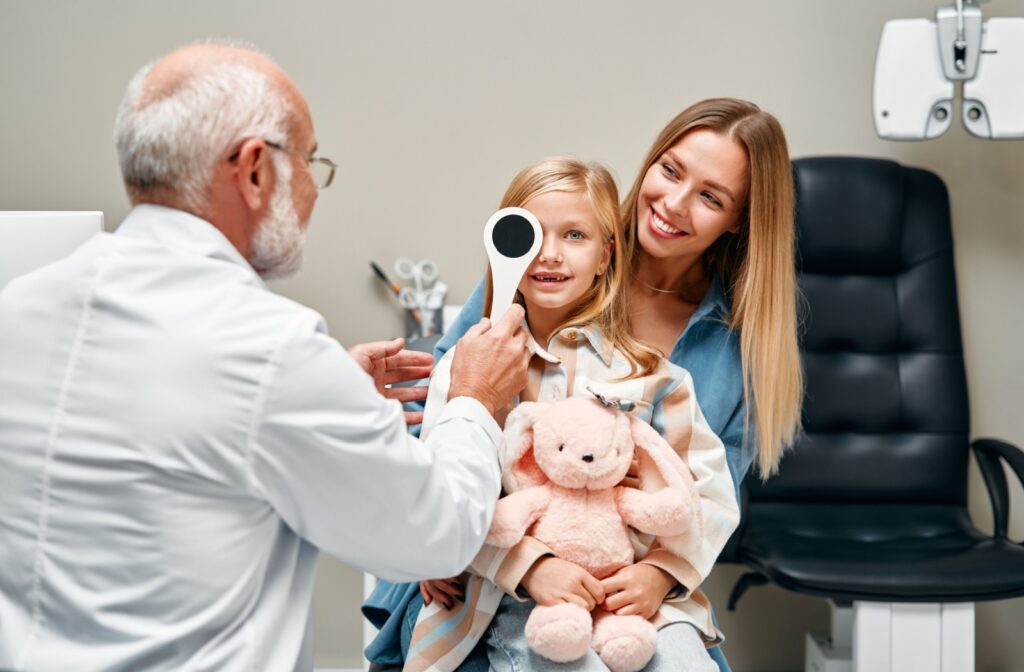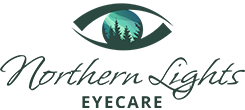Children frequently explore their surroundings with help from their five senses. Yet, we often take healthy vision for granted.
When children start to show signs of difficulty seeing, some parents are hopeful that their child will outgrow these issues over time. In addition some children may find glasses intimidating or otherwise undesirable.
However, not wearing glasses won’t result in improvements to a child’s eyesight. On the contrary, failure to wear prescribed glasses may eventually lead to complications.
In particular, some of the most significant issues with children’s vision are refractive errors like myopia (nearsightedness), which occur due to structural change in the eye’s physical shape and function. Failure to address these issues and control myopia may result in your child’s vision getting worse.
Eyes Growth, Vision, & Development
Our ability to process visual information allows us to interact with and explore our surroundings. Our eyes help make this possible.
As we progress through childhood and into adolescence, our eyes grow and develop. The anatomy and structure of our eyes changes as a result of genetic predisposition, environmental factors, and overall health. These changes include:
- The eye increases in size
- Coordination between the eyes strengthens
- Muscles that control eye movement become more precise
This growth naturally stabilizes around the age of 21, which is often when a person’s vision prescription stops fluctuating.
However, this process of development isn’t always without challenges. For some children, structural variations in the eye can lead to vision issues. Refractive errors are among the most common of these.
Common Refractive Errors in Children
Refractive errors are vision issues that make it hard for a person to see clearly. They can develop at any age, but generally manifest in childhood as the eyes continue growing.
Refractive errors occur when light entering the eye doesn’t focus correctly on the retina, leading to blurry vision. In children, these errors commonly include:
- Myopia (nearsightedness): The eye’s shape is elongated or the cornea is too curved, causing distant objects to appear blurry while objects nearby remain clear.
- Hyperopia (farsightedness): The eye’s shape is too short, causing nearby objects to appear blurry while those far away are clear.
- Astigmatism: The shape of the cornea or lens becomes irregular, causing light to focus unevenly, leading to distorted or blurry vision at any distance.
Genetics play a role in determining a child’s likelihood of developing refractive errors, but environmental factors can also have a significant impact:
- Spending excessive time indoors or focusing on screens can increase the risk of myopia.
- Exposure to natural sunlight and spending time outdoors can help reduce the risk of developing certain refractive errors.
- Poor posture and improper reading distances may also strain a child’s focus and affect vision over time.

Can Eyesight Improve Without Glasses?
While it’s common to hope a child’s eyesight may naturally improve without needing glasses, it is unlikely.
Refractive errors rarely resolve on their own because they occur due to a structural change in the eye that cannot be reversed with time.
For example, myopia is often a progressive condition, especially during childhood. The lengthening of the eye usually doesn’t stop until growth stabilizes in early adulthood. Hyperopia, although it can improve slightly as the eyeball grows, rarely disappears entirely.
These anatomical changes to the eye’s shape cannot be “corrected” without interventions like glasses, contacts, or surgical procedures.
Complications From Uncorrected Vision
The decision to forgo glasses has consequences beyond compromising a person’s ability to see clearly. While it won’t necessarily worsen vision, it can have long-term impacts:
- Visual Strain: Eye muscles have to work harder causing headaches, eye strain, and poor concentration in school.
- Amblyopia (Lazy Eye): When one eye is significantly weaker than the other, the brain may rely on the stronger eye. This can lead to vision loss in the weaker eye if unaddressed.
- Social & Academic Challenges: Clear vision is key for children to excel at reading, writing, and socializing. Poor eyesight can hinder learning and social interactions.
Supporting Your Child’s Vision
Encouraging your child to wear their glasses is one aspect of supporting their vision. Because children’s eyes are constantly changing, routine eye exams are key for preserving their vision and ocular health.
These comprehensive visits go beyond updating a vision prescription for glasses. During these exams, an optometrist evaluates their vision, how their eyes are focusing, and how they work together as a team.
Some key benefits of children’s eye exams include:
- Preserving Vision Health: Regular checkups help detect and manage eye conditions, including refractive errors and amblyopia early, encouraging timely intervention.
- Tracking Development: Annual exams help monitor any changes in eye health and adjust corrections as necessary.
- Slowing Progression: Some treatments (including myopia control glasses!) can be prescribed early to slow the progression of refractive issues, like myopia.
Some additional ways to support your child’s vision can include:
- Encourage outdoor activities to balance screen time and reduce myopia progression risks.
- Prioritize eye-friendly habits, such as reading with proper lighting and maintaining a healthy posture during activities.
- Teach your child the 20-20-20 rule to help reduce eye strain from screen time. Every 20 minutes, encourage them to look at something 20 feet away for at least 20 seconds.
Annual Eye Exams Through Sask Health
Because children’s eyes are more susceptible to changes, the Canadian Association of Optometrists recommends children 18 and under have an annual eye exam.
Children can have their first exam as early as 6 months old! During this visit, we confirm your child’s vision and eye health are on track as their eyes develop.
The province of Saskatchewan recognizes the vital role that healthy vision plays in a child’s growth and development.
To support this, our provincial healthcare system covers the cost of annual eye exams for children up to the age of 17, helping to remove financial barriers to help.
Schedule an Appointment
Glasses are a necessary tool to help children see clearly. While not wearing glasses doesn’t cause vision to worsen, it can lead to other complications.
Consistently wearing glasses and visiting the eye doctor for routine exams are key ways to support children’s vision.Connect with our team at Northern Lights Eyecare to schedule an appointment.


